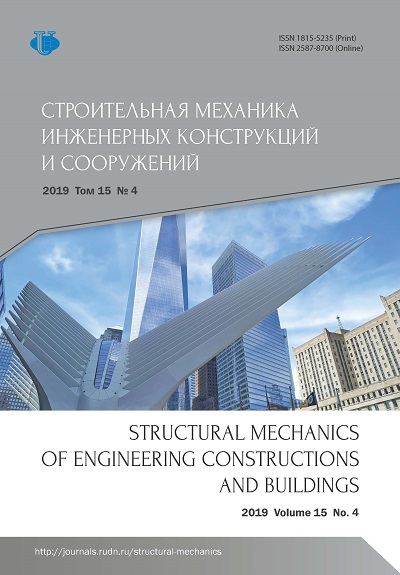Theory of “dissolution” and “condensation” of the physical geometric characteristics of an arbitrary cross-section under the action of torsion with bending
- Authors: Kolchunov V.I.1, Demyanov A.I.1, Naumov N.V.1
-
Affiliations:
- South-West State University
- Issue: Vol 15, No 4 (2019)
- Pages: 261-270
- Section: Analysis and design of building structures
- URL: https://journals.rudn.ru/structural-mechanics/article/view/21803
- DOI: https://doi.org/10.22363/1815-5235-2019-15-4-261-270
Cite item
Full Text
Abstract
Aim of research - to continue the development of methods for determining the stress-strain state of rods during torsion using materials resistance methods. Methods. A new approach for determining tangential torsional stresses for arbitrary cross sectional rods, based on simplified assumptions of material resistance, is proposed. The main feature of this approach is the approximation of rectangular or any complex cross section of reinforced concrete structures by describing a large circle around the cross section and splitting it into small squares with circles inscribed into them. Results. Three theorems have been formulated, the first of which relates the accumulation of tangential stresses (increments) from the edges of a rectangle to the middle of a rectangular section with the formula for determining tangent stresses for round sections. The second theorem allows to establish a connection between the tangential stresses calculated for each of the small squares-circles and the tangent stresses of the large circle through their increments. The third theorem makes it possible to find tangential stresses for each of the small square circles. The proposed approach allows to remove the need to use special tables for the calculation and not only in the elastic stage. It also makes it possible to separate the stress-strain state in the whole set of round cross-sections from the additional field caused by the deplanation of the rectangular cross-section. In addition, the proposed approach makes it possible to take into account the concentration of angular deformations in the incoming angles and other places with changing geometric parameters.
About the authors
Vladimir I. Kolchunov
South-West State University
Author for correspondence.
Email: vlik52@mail.ru
DSc. in Technical Sciences, Professor of the Department of Unique Buildings and Structures
94 50 Let Oktyabrya St., Kursk, 305040, Russian FederationAleksej I. Demyanov
South-West State University
Email: vlik52@mail.ru
PhD in Technical Sciences, Associate Professor of the Department of Unique Buildings and Structures
94 50 Let Oktyabrya St., Kursk, 305040, Russian FederationNikolay V. Naumov
South-West State University
Email: vlik52@mail.ru
graduate student of the Department of Unique Buildings and Structures.
94 50 Let Oktyabrya St., Kursk, 305040, Russian FederationReferences
- Golyshev A.B. (2009). Soprotivlenie zhelezobetona [The resistance of reinforced concrete]. Kiev, Osnova Publ., 432. (In Russ.)
- Bondarenko V.M. (2004). Raschetnye modeli silovogo soprotivleniya zhelezobetona [The computational model of a power resistance of reinforced concrete]. Moscow, ASV Publ., 472. (In Russ.)
- Iakovenko I., Kolchunov V., Lymar I. (2017). Rigidity of reinforced concrete structures in the presence of different cracks. MATEC Web of Conferences. 6th International Scientific Conference “Reliability and Durability of Railway Transport Engineering Structures and Buildings”. Transbud–2017, 116, 02016, 1–12. doi: 10.1051/ matecconf/201711602016
- Demyanov A., Kolchunov Vl. (2017). The dynamic loading in longitudinal and transverse reinforcement at instant emergence of the spatial сrack in reinforced concrete element under the action of a torsion with bending. Journal of Applied Engineering Science, 15, 456, 377–382. doi: 10.5937/jaes15-14663
- Jariwalaa V.H., Patel P.V., Purohit S.P. (2013). Strengthening of RC Beams Subjected to Combined Torsion and Bending with GFRP Composites. Procedia Engineering, 51, 282–289.
- Rahal K.N., Collins M.P. (2006). Compatibility Torsion in Spandrel Beams Using Modified Compression Field Theory. ACI Structural Journal, 103(3), 328–338.
- Demyanov A.I., Kolchunov Vl.I. (2018). To the approximation of rectangular and complex cross-sections of reinforced concrete structures under the action torsion with bending. IOP Conference Series: Materials Science and Engineering, 456, 012104, 1–12. doi: 10.1088/1757-899X/ 456/1/012104
- David A.E., Thomas L.H., Simon A.N., Jonathan E.C. (2018). Veering and nonlinear interactions of a clamped beam in bending and torsion. Journal of Sound and Vibration, 416, 1–16.
- Loïc B., Guilhem M., Rached F., Bruno C. (2016). Static and dynamic analysis of bending-torsion coupling of a CFRP sandwich beam. Composite Structures, 145, 26–36. doi: 10.1016/j.compstruct.2016.02.055
- Ogawa Y., Kawasaki Y., Okamoto T. (2014). Fracture behavior of RC members subjected to bending shear and torsion using acoustic emission method. Construction and Building Materials, 67, 165–169. doi: 10.1016/ j.conbuildmat.2014.05.100
- Lukina A.A., Kholopova I.S., Alpatova V.Y., Solovieva A.V. (2016). Beams with corrugated web: calculation peculiarities of bending torsion analysis. Procedia Engineering, 153, 414–418. doi: 10.1016/j.proeng.2016.08.143
- Kashani M.T., Hashemi S.M. (2018). A finite element formulation for bending-torsion coupled vibration analysis of delaminated beams under combined axial load and end moment. Shock and Vibration, 2018, 1348970, 1–13.
- Kolchunov Vl.I., Demyanov A.I. (2019). K opredeleniyu napryazhenno-deformirovannogo sostoyaniya sterzhney proizvolnogo poperechnogo secheniya pri kruchenii metodami soprotivleniya materialov [To determination of stress-strain state for a rod of arbitrary cross-section under torsion using resistance of materials]. Buildings and Reconstruction, 81(1), 10–22. (In Russ.)
- Murashev V.I. (1950) Treshchinoustoychivost, zhestkost i prochnost zhelezobetona [Crack resistance, stiffness and strength of reinforced concrete]. Moscow, Mashstroyizdat Publ., 268. (In Russ.)
















